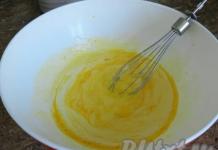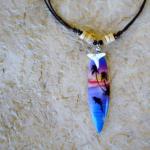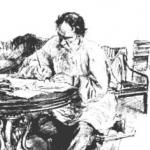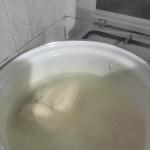My daughter bought UV nail polishes. Now she needs a dryer. Dryer prices are high. I suggested buying a UV lamp first for testing, especially since there is a lamp for it. Well, we'll see there. The lamp arrived, but refused to work in the lamp. I had to treat it. I’ll tell you about this. If anyone is interested, let's go.
The light bulb, although made of glass, arrived intact. No scratches, no chips, no other damage. 
The first thing my daughter did was stick it in the lamp. Even though we haven’t used it for a long time, we haven’t thrown it away. 
But the miracle did not happen. The light did not light up. The first thing I thought was that the filament was shaken during transportation. This is difficult to do (but possible), since the filament of such lamps is much thicker than that of incandescent lamps. Here is a standard diagram for switching on fluorescent lamps. 
My lamp does not have a capacitor at the input, so I crossed it out. The peculiarity of the lamp is that in this bulb the starter is located inside.
I took the light bulb and rang it. The device showed 3300pF. This means the filaments are alive. The problem is in the starter (I thought). I didn’t know that there are varieties of light bulbs without a starter inside. This is not indicated on the seller's page either. I took up the task of disassembling the lamp (not for the sake of economy, but for the sake of interest). 
Breaking a light bulb is not mind-boggling. The task is to restore functionality. In order to disassemble, you need to drill out the crimped wires (no other way) and carefully bend the crimps on the aluminum casing. 
But there is no starter! And without it, the light bulb in such a lamp will not work. 
I took a working starter from a similar (9W) faulty lamp. 
I extended the short leads and put on insulating tubes (just in case). Collected. I soldered the leads through the drilled holes and bit off the excess (with side cutters). 
Everything is working.
Another option is possible. You can also use an electronic driver from an old energy-saving device. 
The only problem is that it’s difficult to install (purely structurally) into such a lamp, but it will work. The throttle will need to be removed. I don’t recommend removing it (the throttle), leave it for stability.
What I want to say at the end. Using a light like this to dry your nails is NOT GOOD. For these purposes, specialized lamps are sold that protect you to the maximum extent from exposure to ultraviolet radiation. The use of such a lamp can only serve as a temporary measure. Take care of your eyes.
That's all.
Good luck everyone!
All representatives of the fair sex love to take care of their nails and often visit beauty salons for manicure procedures. It’s just that earlier, in order to get a permanent manicure, you had to look for a skilled manicure and pay a lot of money, but today it can be done at home. But you will need a special lamp and materials for this. It is important to choose a high-quality device in order to perform the necessary manipulations yourself. Knowing how to make a UV lamp for nails with your own hands, you can save a lot. Today we will not only understand this issue, but also take a closer look at the operating features of the most popular types of manicure dryers.
Features of operation and main characteristics of lamps for manicure
Electric lamps are quite popular among manicurists and lovers of creating high-quality and long-lasting nail art with their own hands. To purchase a ready-made device that meets your requirements, you should first familiarize yourself with the main characteristics, features, design and advantages of such devices. In addition, if you know them, stock up on everything you need, then you will get a decent nail dryer with your own hands.
Table lamps have the simplest design:
- Ordinary body.
- External control panel.
- Special light bulbs.
- Timer.
- Fan.
Important! Some dryers have more functions, but their cost increases greatly due to this.

Let's look separately at each parameter that needs to be paid attention to:
- Dimensions. The most important difference between all lamps is their overall dimensions. There are models that allow you to dry permanent coating on both hands at the same time. When choosing a device for home use, you can safely choose a small lamp, without a timer or additional functions. It is inexpensive, takes up minimal space, and consumes energy sparingly.
- Power. This is also very important. Modern manicure installations have power ratings ranging from 9-54 watts. They can have from 1 to 4 special lamps at the same time. Low-power appliances are being used less and less, even for home use.
Important! The optimal option is 36 watts. Naturally, nail salons use more powerful models.
Types of nail dryers
When creating nail art, it should be taken into account that ultraviolet rays affect each layer of varnish separately. Therefore, the total time for the total effect of ultraviolet radiation on the entire nail plate should not exceed ten minutes. Otherwise, you will violate sanitary standards; your nails and skin may be seriously damaged. If you plan to do a multi-layer manicure yourself, then buy quick-drying coatings.
Currently there are the following types of lamps:
- Ultraviolet dryers. All manicure devices are equipped with fluorescent or LED lamps. But the ultraviolet lamp for drying gel polish is the most affordable. With your own hands, you can use it to create real masterpieces on your nails; the main thing is to use it correctly and not violate established rules and regulations. This model can be purchased on the Internet, a specialized store, or even made by yourself.
Important! Their only disadvantage is the short life of the light bulbs used inside and the content of mercury in them that is hazardous to health.
- LED lamps for nails. Today they are considered the best in this field. Such devices operate using LEDs, so the drying process is completely safe for health, economical, and fast. Polymerization takes place in just 20-30 seconds, meaning there is no need to wait three minutes. There are no harmful substances inside the lamp, so if it breaks, no one will be harmed.
Important! LEDs do not become less powerful over time.
To summarize, it becomes quite clear how they differ. LED lamps are something new for the fashion and beauty industry. Ultraviolet dryers are considered a proven and cheap option, which is once again proven by the current review of lamps for drying nails from various manufacturers. The main advantage of LEDs is their long service life, which devices with fluorescent lamps cannot boast of. But the most important thing is that LED models are absolutely safe.
Important! When planning to make such a device and use it at home, also read interesting information from our other publications:

Making a manicure lamp with your own hands
If you really want to save money, then try making your own drying device. A DIY manicure lamp is made using the lamp itself. Be sure to collect everything you need before starting work:
- UV light bulb (inexpensive models, for example, those used in machines for checking banknotes).
- Energy saving light bulb that fits a standard size socket.
- Block for screws.
- Lamp socket and wire with plug.
The lamp is quite inexpensive, but the rest of the materials can be found at home or in any lighting store. To make or replace diodes, you can buy them there. Repair and replacement of parts is also not difficult to do..
The assembly diagram of the ultraviolet dryer consists of the following steps:
- We screw a UV lamp onto the pads. Since it is quite difficult to find connectors, it is better to use pads. We connect the wires to the blocks. LAN cables are ideal in this case; you just need to twist the wires in them in pairs and use them together.
- We take out the plate with electronics from the energy-saving lamp. We cut off a couple of wires coming out of it to the bulb, then unsolder it and solder the twisted wires in pairs in their place. We reassemble the base with electronics. As a result, we will have a power source for our lamp.
- We attach the device using a plastic strip to the base and get the base of the dryer.
- You can use a ready-made case or make it yourself from an old computer power supply.
- We insert the lamp into the housing.
Important! Once you have practiced with the device you assembled yourself, you may still want to buy a more effective device from the professional series. Or maybe you even want to develop your business in this direction. Then our articles will help you:
Related materials:
Professional UV CCFL/LED hybrid nail lamp ZS-LCL016 for 2 hands. CCFL+ LED UV Nail Lamp Review. Photo. We present to your attention the Professional UV CCFL/LED hybrid nail lamp ZS-LCL016 for 2 hands. Professional UV CCFL/LED Hybrid Nail Lamp...

UV lamp for nails 3610 (induction UV lamp for gel and gel polish). Review by AmoreShop. Review of ultraviolet lamps for nails (UV device 9w). Photo. This lamp is suitable for gels and gel polishes (for shellac). UV lamp for nails 3610 (induction UV lamp...

LED lamp for nails. How to choose? Review of ultraviolet lamps for nails (UV device 9w). Photo. Comparison of LED lamps for manicure. All the advantages of LED nail lamps compared to conventional UV lamps. LED lamp for nails. How to choose? Review...

Gel for nail extension. Milling machine for hardware manicure, pedicure, nail extensions, etc. Photo. Gel nail polishes, nail extensions and dried with a UV lamp. Gel for nail extension. Nozzles as a gift. Milling machine for hardware manicure, pedicure, nail extensions, etc. To get a manicure...

UV lamp for drying gel polish. Ultraviolet LED nail dryer. Photo. Drying gel polish with a UV lamp. UV lamp for drying gel polish. Features: Curing lamp can be used to dry the gel on nails, especially for curing nail gel and UV coat. Environmental protection, light use...
Every modern nail salon has an ultraviolet lamp in its arsenal. It is used to dry applied shellac or nail extensions. For home use, the device is a little expensive, so even if you purchased it, you want to use it longer.
If a lighting element fails, repair organizations will require at least half a thousand rubles for repairs, but at home, with the necessary knowledge, costs can be reduced significantly. In addition, by purchasing the appropriate parts, you can even assemble such a lamp yourself.
To replace an outdated or burnt-out lamp in the device, you must follow these steps:
- Turn off the device using a special button, if available, and disconnect from the network. Turn the box over, unscrew all the retaining parts of the base and cover of the case, for convenience, place the screws in a small closed container or matchbox so that they do not get lost.
- The device turns over into its usual position with support for the lower part of the block so that it does not fall off and the existing parts are not damaged.
- Carefully remove the top of the device. This should be done easily, without crackling, extraneous sounds, etc. The main thing is not to damage fragile lamps and electrical contacts.
IMPORTANT! As a rule, connecting wires are attached to the rear wall at the top of the case, leading to the control buttons from the board located on the base. Therefore, the cover should open “like a door” with minimal movement of parts of the housing so that the wires do not come off. Then it will be difficult to connect them without special equipment.
- A non-working or outdated lamp is identified and is very easily pulled out of the socket so that it does not crack in your hands, since the base is usually hidden inside a mirror structure in order to less scatter the emitted ultraviolet rays.
- In place of the old lamp, a lamp of similar power and dimensions must be inserted in order for the device to work correctly. The part is simply placed in the socket at the appropriate joints, easily pushed all the way so that the metal contacts are installed in place.
REFERENCE! Depending on the design of the device, to replace the UV lamp, you don’t have to disassemble it, but simply remove the damaged one and insert a whole lamp in its place. The main thing is that at this moment the device is disconnected from the network. It is easier to remove the lamp if you push it with your finger from the back of the socket, then you do not need to squeeze the glass bulbs. Unwinding the equipment reduces the risk of damaging the fragile glass in your hands.
- Close the top cover of the device so that the housing snaps into place. Typically, manufacturers produce plastic devices with self-locking box parts, and screws are provided for secure fastening.
- Before screwing in the device, you can check that the new lamp is connected correctly; to do this, you need to make sure that no wires are sticking out of the case, connect the equipment to the network, and press the power button. If the lamp does not work, you should turn off the device, lift the cover again and check the integrity of the installed lamp and its correct connection.
- All screws are inserted into place and screwed securely.
IMPORTANT! If the device body is plastic, and the screw socket on the body is not equipped with a metal insert (this is the case with most devices), you should control the degree of tightening of the bolts so as not to cut off the plastic threads or split the fasteners.
How to change in ICE?
Lamps for manicure based on conventional tube ultraviolet lighting elements are considered more outdated compared to their analogues with LEDs or, as they are also called, LED lamps. There are no individual LEDs that are used in manicure machines available for free sale. Therefore, to replace damaged elements, you will need a “donor” - a broken or the cheapest lamp in the segment.
To replace you will need: an iron, a powerful soldering iron, a screwdriver, wire cutters, a utility knife, an LED lamp with a burnt out or lost element, a “donor” device for LEDs, tweezers, fluxes, resealable small containers for LEDs and device bolts, preferably 2 for each device so that small elements do not get lost. All actions are performed according to the following instructions:
- The housing of both lamps is disassembled one by one. To do this, you need to find the exits of the screw caps, use a screwdriver to unscrew them all, place them in closed containers, you can use matchboxes.
- Carefully open the covers, taking into account that the connecting wires of the top cover buttons and the LEDs on the base are usually short and can easily break.
- Disconnect the connecting cables through the special connectors in order to work only with the base of each lamp.
- The plates on which the burnt or lost LEDs are located are unscrewed.
- Using a heated, powerful soldering iron, the back part of the fixed plate is heated, where the lighting element is supported by tweezers. As a result of sufficient heating, the part should detach on its own. If this does not happen, but some traces of adhesive or other substance remain, you need to use a utility knife or wire cutters to clean the place where the diode is attached, and use a hot soldering iron to remove the excess from the surface of the socket.
- Removing the diodes from the donor device is easier: the board with the lighting elements is removed, the reverse side is placed on the surface of a heated iron, fixed in a rigid position, the edges of the LEDs are coated with flux.
- After 20–25 seconds, remove the part that has come off the board. As a rule, this time is enough, but it is better to always keep tweezers at the ready.
IMPORTANT! Avoid overheating the LEDs, as this may damage them or reduce their service life.
- Before soldering, it is necessary to determine the correct polarity of the LED, usually this is marked on the board, and on the element “-” on the ground corner. The place where the diode is attached is first coated with flux, the part is installed on it, and using a hair dryer or a 60-watt soldering iron, the “landing” point is heated on the back side of the plate.
- The board on which all manipulations were performed should cool to room temperature. After this, the corresponding wires of the housing parts are connected, the device is carefully and very carefully connected to the network and its functionality is checked. If problems are found, it is necessary to find an error in the actions taken.
- If the installed LED works, you should put the lamps back together, clean up the area after yourself, and lay out the tools.
- The device is now ready for use.
How often should you change a light bulb and how do you know when it’s time to change it?
It is almost impossible to predict exactly how and when the lighting element in an ultraviolet lamp will need to be replaced. This depends on the amount of total operating time and the frequency of on-off switching. In home use, you can even wait for a separate illuminator to completely fail, which is unacceptable for salons.
With a busy work schedule, tube-type light bulbs are changed on average 4-6 times a year. This is due to aging lamps that are not able to produce the luminous flux of the required intensity. The gel will take longer to harden. In complex aquarium designs, the bottom layer, with a thick coating, does not harden at all, leaving the thin colored gel mobile.
It is impossible to determine by appearance that the coating technology was violated due to a low-quality lamp, however, the duration of use of the manicure is significantly reduced. Also, the lamps require replacement if they stop drying. They emit normal light without affecting the structure of the gel coating. It can also be determined by the increase in drying time; if it has increased by more than 50% from the nominal one, you should think about purchasing a new lighting point.
Do-it-yourself repair of ultraviolet drying gel nail polish
There are several reasons why ultraviolet lamps fail:
- The LED lamp driver burns out.
- The resource runs out and the tubular lamp ceases to perform its functions.
- Any type of lighting element burns out.
- The power supply fails.
To repair, it is necessary to determine the cause and essence of the breakdown. If this is just a burnt-out lighting point, then the easiest way to replace it in tubular UV lamps is by simply replacing it with a new one. In LED lighting devices, it is necessary to completely disassemble the equipment, remove the burnt element, and solder a working element in its place.
If the driver burns out, you should determine which LED has failed. The difficulty is that not all of them light up and it is impossible to visually diagnose the point of failure. To do this, the elements are removed one by one, tested with a multitester and, if they work, soldered back in, the broken one is replaced until the entire device is fully operational.
The power supply can be repaired by a specialized service center or completely replaced at home. As a rule, the structure of a part is complex, and without the necessary skills it will not be easy to understand what exactly is wrong with it.
How to do UV drying with your own hands?
Before you start assembling an ultraviolet nail lamp yourself, you should familiarize yourself with the following features of their launch systems:
- Electronic– characterized by high vulnerability to current surges in the network, lighter and simpler in design.
- Induction– heavier due to starting through the starter and choke, which make the device heavier; after switching on, the light flashes for a while, but is more resistant to mains current surges.
To assemble a UV lamp yourself, you will need to remove the base with the existing system, so it is better to take inexpensive illuminators.
List of required materials:
- Ballast as a ballast for limiting current of induction or electronic type. It is necessary to select this element so that its power matches the corresponding indicators of the lamp used.
- Fluorescent lamps.
- Food grade or self-adhesive foil is used to cover the internal cavity of the device to increase reflectivity.
- The housing is plastic, it can be used from another old device, just adapt it to the characteristics of the lamp.
- Cable with plug for connecting to a 220 V network.
- The control button can be in a standard form with an “On”/“Off” mode in the form of a push or roll type.
- Soldering iron.
Instructions for preparatory work on assembling the ultraviolet lamp housing:
- Calculate the power of the device depending on the number of lamps used. If the lighting element has a power of 9 W, then when installing 3 of them in the device, the total power will be 27 W, with 4 lamps - 36 W, respectively. With higher power, the polymerization rate increases.
- Due to the ability to heat up during lamp operation, you should select a housing that will protect against burns. Thick plexiglass, wooden panels, casings from old unnecessary appliances, etc. work well.
- On paper, draw a diagram of the arrangement of the elements, calculate the number of wires and necessary parts, you should also decide on the appearance of the device, its shape and placement of the illuminators so that they do not interfere with your hands, do not hinder movements and can dry the gel.
- Think about how everything will be attached to the case, make all the spacers, panels, outputs and sockets for lamps, places for laying wires, an outlet for a button and a network cable.
- Cover the inner surface of the case with foil, trying to make it as even as possible, then the light will be better reflected and focused on the nails.
The procedure for assembling the electronic part of the lamp:
- Remove the base from the lamp, to do this, use wire cutters to separate the legs, remove the white base, prying it under the metal rim, after which 4 wires become visible, the first pair of which connected the starter, and the second pair went out to the legs;
- Connect the lamps to each other with wires, connect them to the ballast so that the outputs to the cord are located on one side, and the contacts for connecting the lamps themselves are on the other;
- Connect the cord to the electronic part and connect the button;
- Connect the assembled system to the network and check its functionality;
- Install the previously prepared “filling” into the body.
With certain skills, the duration of the process of assembling the electronic component of the device is approximately an hour. The case will take a little more time, it all depends on the chosen material, mounting methods, and imagination with the design.
Conclusion
An ultraviolet lamp for manicure is a modern device, without which it is difficult to imagine this process. Extensions or shellac simply will not be able to harden without this device. For home use, you can easily assemble the device yourself, but you should not use it for work. Some clients may require a license for the device because they do not want to risk their health. And a self-respecting master will not resort to handicraft devices.
It is easy to deal with problems in the operation of UV manicure devices if it is limited to the failure of the illuminator, as well as to replace it. For more serious problems, it is better to contact a workshop for qualified help. Amateur work without the necessary knowledge inside the device threatens to break the device and pose a danger to the health and life of the “would-be master”.
The boy brought a lamp.
The transistors burned out, I replaced them with field switches from the motherboard, but they hiss, heat up and burn out.
- Do you have original transistors?
- Eat.
I looked, and my relatives there 2SC3303.
Why did you change them specifically to field devices from the motherboard?
- So they are the same.
And indeed, if you put them side by side, they are the same, well, unless, of course, you look closely at the markings. When he returned, he severely punished him, if he wants to achieve something and learn, never commit thoughtless actions.
An external inspection showed that the pads under the transistors were torn off and there was a bug instead of a 2.5 A fuse.


And, of course, the containers were replaced, how could we not do without it. I checked the timer, it turned out to be working.
Since I didn’t have 2SC3303, the pads were damaged, and I didn’t want to put it off, I decided to install the existing KT805IM there, which differ only in the location of the base and emitter pins. And the powerful “sole” of the 805s is incomparable with the platforms for the 2SC3303 in terms of cooling. I drilled the board, placed bushings under the flanges and soldered the transistors.

I connected everything, turned it on, the LEDs glowed, but the lamp did not. Okay, I’ll go read about these lamps, what voltage they require. And in one review I come across a phrase from a girl. “And your lamp doesn’t light either?” Here I am, a horse! I turn off the LEDs and the lamp lights up. Its visible glow is very weak and is illuminated by LED light. The renovation is complete.
The timer chip is not marked; just in case, I removed the state table from it.

It was not possible to synchronize the frequency of the high near-sinusoidal voltage generator; it is approximately 33 kHz.
CCFL (cold cathode fluorescent lamp) small Watt 5-6 maximum,

If we compare visually with the 9 W lamp that I saw before. But certainly not 12 watts, as it says on the cover.
The LED part is made on 4 aluminum strips, which are supplied with 12 Volts, with a small radiator in the form of a plate on each, the strips are connected in parallel. Each line has 3 double-crystal LEDs and a 3.9 Ohm resistor installed. This means that the crystals in each LED are connected in parallel, and the LEDs and resistor are connected in series. Each line is powered by a current of 0.35 A, therefore, the total power of the LED part is about 13-14 Watts, but not 24 Watts, as it is written on the cover. Although this is usual for the Chinese, they installed 24 crystals, which means there are 24 watts, and the fact that each crystal operates in half-watt mode does not bother anyone. The rulers are controlled through the 9926A assembly, in which the field strips are connected in parallel. If double-crystal LEDs fail, you won’t be able to find them and you’ll have to do something clever. The screws for fastening rulers and radiators do not have a slot, which is not very good.

The photo shows that these screws were unscrewed on the left and self-tapping screws were installed instead. It is not clear what housing the LEDs are made in, and there was no desire to unscrew the screws without a slot. The lamp is powered by a 12 V/3 A external power supply, which is quite light for such parameters,




















